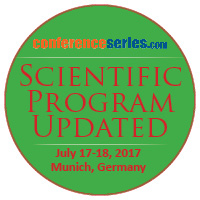
Cosimo Nardi
University of Florence, Italy
Title: The role of cone beam CT with large field of view in Goldenhar syndrome
Biography
Biography: Cosimo Nardi
Abstract
Introduction: Goldenhar syndrome is a rare disease with hemifacial microsomia and craniofacial disorders originating from the first and second branchial arches such as ocular, auricular and vertebral anomalies. Complexity and variety of the spectrum of disease presentation usually require several examinations. This study aimed to evaluate the efficacy of cone beam CT in Goldenhar syndrome.
Methods: Ten patients (7–14 years) were evaluated via NewTom5G CBCT with large field of view (18x16 cm). Ten anatomical facial landmarks were identified to measure the following distances, bilaterally: sella turcica (ST)-mandibular angle, ST-condyle, ST-mastoid, ST-mental foramen, ST-frontozygomatic suture, ST-zygomaticotemporal suture, ST-zygomaticofacial foramen, ST-sphenopalatine fossa, mandibular angle-mandibular symphysis, and mandibular angle-condyle. The following six volumes were calculated, bilaterally: orbit, maxillary sinus, condyle, external ear canal, middle ear, and internal auditory canal. The aforementioned linear and volumetric measurements were performed to assess skeletal asymmetries comparing the non-affected side with the affected side by Wilcoxon test. Cervical spine anomalies were classified in fusion anomalies and posterior arch deficiencies.
Results: All patients showed a deficit of skeletal development in the affected side. Statistically significant differences between the non-affected side and affected side (p-value=0.043) were recorded for all measurements, except for ST-frontozygomatic suture, mandibular angle-mandibular symphysis, and maxillary sinus volume. Vertebral fusion anomalies and posterior arch deficiencies were found in seven and four patients, respectively.
Conclusions: CBCT with large field of view was able to (1) accurately identify craniofacial and vertebral skeletal anomalies at one time, and (2) quantify asymmetries between non-affected side and affected side providing quantitative data appropriate for maxillofacial medical/surgical planning.

